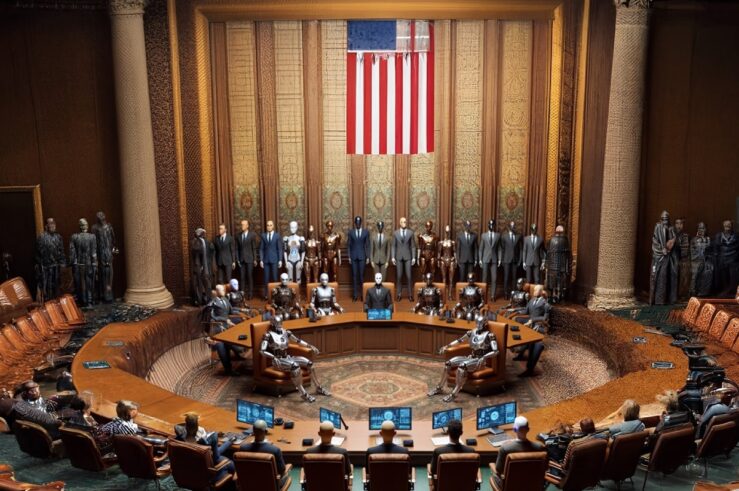
There is a line of thinking according to which, without merger-control rules, antitrust law is “incomplete.”[1] Without such a regime, the argument goes, whenever a group of companies faces with the risk of being penalized for cartelizing, they could instead merge and thus “raise prices without any legal consequences.”[2]
A few months ago, at a symposium that INDECOPI[3] organized for the first anniversary the Peruvian Merger Control Act’s enactment,[4] Rubén Maximiano of the OECD’s Competition Division argued in support of the importance of merger-control regimes with the assessment that mergers are “like the ultimate cartel” because a merged firm could raise prices “with impunity.”
I get Maximiano’s point. Antitrust law was born, in part, to counter the rise of trusts, which had been used to evade the restriction that common law already imposed on “restraints of trade” in the United States. Let’s not forget, however, that these “trusts” were essentially a facade used to mask agreements to fix prices, and only to fix prices.[5] They were not real combinations of two or more businesses, as occurs in a merger. Therefore, even if one agree that it is important to scrutinize mergers, describing them as an alternative means of “cartelizing” is, to say the least, incomplete.
While this might seem to some to be a debate about mere semantics, I think is relevant to the broader context in which competition agencies are being pushed from various fronts toward a more aggressive application of merger-control rules.[6]
In describing mergers only as a strategy to gain more market power, or market share, or to expand profit margins, we would miss something very important: how these benefits would be obtained. Let’s not forget what the goal of antitrust law actually is. However we articulate this goal (“consumer welfare” or “the competitive process”), it is clear that antitrust law is more concerned with protecting a process than achieving any particular final result. It protects a dynamic in which, in principle, the market is trusted to be the best way to allocate resources.
In that vein, competition policy seeks to remove barriers to this dynamic, not to force a specific result. In this sense, it is not just what companies achieve in the market that matters, but how they achieve it. And there’s an enormous difference between price-fixing and buying a company. That’s why antitrust law gives a different treatment to “naked” agreements to collude while also contemplating an “ancillary agreements” doctrine.
By accepting this (“ultimate cartel”) approach to mergers, we would also be ignoring decades of economics and management literature. We would be ignoring, to start, the fundamental contributions of Ronald Coase in “The Nature of the Firm.” Acquiring other companies (or business lines or assets) allows us to reduce transaction costs and generate economies of scale in production. According to Coase:
The main reason why it is profitable to establish a firm would seem to be that there is a cost of using the price mechanism. The most obvious cost of ‘organising’ production through the price mechanism is that of discovering what the relevant prices are. This cost may be reduced but it will not be eliminated by the emergence of specialists who will sell this information. The costs of negotiating and concluding a separate contract for each exchange transaction which takes place on a market must also be taken into account.
The simple answer to that could be to enter into long-term contracts, but Coase notes that that’s not that easy. He explains that:
There are, however, other disadvantages-or costs of using the price mechanism. It may be desired to make a long-term contract for the supply of some article or service. This may be due to the fact that if one contract is made for a longer period, instead of several shorter ones, then certain costs of making each contract will be avoided. Or, owing to the risk attitude of the people concerned, they may prefer to make a long rather than a short-term contract. Now, owing to the difficulty of forecasting, the longer the period of the contract is for the supply of the commodity or service, the less possible, and indeed, the less desirable it is for the person purchasing to specify what the other contracting party is expected to do.
Coase, to be sure, makes this argument mainly with respect to vertical mergers, but I think it may be applicable to horizontal mergers, as well, to the extent that the latter generate “economies of scale.” Moreover, it’s not unusual for many acquisitions that are classified as “horizontal” to also have a “vertical” component (e.g., a consumer-goods company may buy another company in the same line of business because it wants to take advantage of the latter’s distribution network; or a computer manufacturer may buy another computer company because it has an integrated unit that produces microprocessors).
We also should not leave aside the entrepreneurship element, which frequently is ignored in the antitrust literature and in antitrust law and policy. As Israel Kirzner pointed out more than 50 years ago:
An economics that emphasizes equilibrium tends, therefore, to overlook the role of the entrepreneur. His role becomes somehow identified with movements from one equilibrium position to another, with ‘innovations,’ and with dynamic changes, but not with the dynamics of the equilibrating process itself.
Instead of the entrepreneur, the dominant theory of price has dealt with the firm, placing the emphasis heavily on its profit-maximizing aspects. In fact, this emphasis has misled many students of price theory to understand the notion of the entrepreneur as nothing more than the focus of profit-maximizing decision-making within the firm. They have completely overlooked the role of the entrepreneur in exploiting superior awareness of price discrepancies within the economic system.”
Working in mergers and acquisitions, either as an external advisor or in-house counsel, has confirmed the aforementioned for me (anecdotal evidence, to be sure, but with the advantage of allowing very in-depth observations). Firms that take control of other firms are seeking to exploit the comparative advantages they may have over whoever is giving up control. Sometimes a company has (or thinks it has) knowledge or assets (greater knowledge of the market, better sales strategies, a broader distribution network, better access to credit, among many other potential advantages) that allow it to make better use of the seller’s existing assets.
An entrepreneur is successful because he or she sees what others do not see. Beatriz Boza summarizes it well in a section of her book “Empresarios” in which she details the purchase of the Santa Isabel supermarket chain by Intercorp (one of Peru’s biggest conglomerates). The group’s main shareholder, Carlos Rodríguez-Pastor, had already decided to enter the retail business and the opportunity came in 2003 when the Dutch group Ahold put Santa Isabel up for sale. The move was risky for Intercorp, in that Santa Isabel was in debt and operating at a loss. But Rodríguez-Pastor had been studying what was happening similar markets in other countries and knew that having a stake in the supermarket business would allow him to reach more consumer-credit customers, in addition to offering other vertical-integration opportunities. In retrospect, the deal can only be described as a success. In 2014, the company reached 34.1% market share and took in revenues of more than US$1.25 billion, with an EBITDA margin of 6.2%. Rodríguez-Pastor saw the synergies that others did not see, but he also dared to take the risk. As Boza writes:
‘Nobody ever saw the synergies,’ concludes the businessman, reminding the businessmen and executives who warned him that he was going to go bankrupt after the acquisition of Ahold’s assets. ‘Today we have a retail circuit that no one else can have.’
Competition authorities need to recognize these sorts of synergies and efficiencies,[7] and take them into account as compensating effects even where the combination might otherwise represent some risk to competition. That is why the vast majority of proposed mergers are approved by competition authorities around the world.
There is some evidence of companies that were sanctioned in cartel cases later choose to merge,[8] but what this requires is that the competition authorities put more effort into prosecuting those mergers, not that they adopt a much more aggressive approach to reviewing all mergers.
I am not proposing, of course, that we should abolish merger control or even that it should necessarily be “permissive.” Some mergers may indeed represent a genuine risk to competition. But in analyzing them, employing technical analytic techniques and robust evidence, it is important to recognize that entrepreneurs may have countless valid business reasons to carry out a merger—reasons that are often not fully formalized or even understood by the entrepreneurs themselves, since they operate under a high degree of uncertainty and risk.[9] An entrepreneur’s primary motivation is to maximize his or her own benefit, but we cannot just assume that this will be greater after “concentrating” markets.[10]
Competition agencies must recognize this, and not simply presume anticompetitive intentions or impacts. Antitrust law—and, in particular, the concentration-control regimes throughout the world—require that any harm to competition must be proved, and this is so precisely because mergers are not like cartels.
[1] The debate prior to the enactment of Peru’s Merger Control Act became too politicized and polarized. Opponents went so far as to affirm that merger control was “unconstitutional” (highly debatable) or that it constituted an interventionist policy (something that I believe cannot be assumed but is contingent on the type of regulation that is approved or how it is applied). On the other hand, advocates of the regulation claimed an inevitable scenario of concentrated markets and monopolies if the act was not approved (without any empirical evidence of this claim). My personal position was initially skeptical, considering that the priority—from a competition policy point of view, at least in a developing economy like Peru—should continue to be deregulation to remove entry barriers and to prosecute cartels. That being said, a well-designed and well-enforced merger-control regime (i.e., one that generally does not block mergers that are not harmful to competition; is agile; and has adequate protection from political interference) does not have to be detrimental to markets and can generate benefits in terms of avoiding anti-competitive mergers.
In Peru, the Commission for the Defense of Free Competition and its Technical Secretariat have been applying the law pretty reasonably. To date, of more than 20 applications, the vast majority have been approved without conditions, and one conditionally. In addition, approval requests have been resolved in an average of 23 days, below the legal term.
[2] See, e.g., this peer-reviewed 2018 OECD report: “The adoption of a merger control regime should be a priority for Peru, since in its absence competitors can circumvent the prohibition against anticompetitive agreements by merging – with effects potentially similar to those of a cartel immune from antitrust scrutiny.”
[3] National Institute for the Defense of Competition and the Protection of Intellectual Property (INDECOPI, after its Spanish acronym), is the Peruvian competition agency. It is an administrative agency with a broad scope of tasks, including antitrust law, unfair competition law, consumer protection, and intellectual property registration, among others. It can adjudicate cases and impose fines. Its decisions can be challenged before courts.
[4] You can watch the whole symposium (which I recommend) here.
[5] See Gregory J. Werden’s “The Foundations of Antitrust.” Werden explains how the term “trust” had lost its original legal meaning and designated all kinds of agreements intended to restrict competition.
[6] Brian Albrecht, “Are All Mergers Inherently Anticompetitive?”
[7] See, e.g., the “Efficiencies” section of the U.S. Justice Department and Federal Trade Commission’s Horizontal Merger Guidelines, which are currently under review.
[8] See Stephen Davies, Peter Ormosiz, and Martin Graffenberger, “Mergers After Cartels: How Markets React to Cartel Breakdown.”
[9] It is always useful to revisit, in this regard, Judge Frank Easterbrook’s classic 1984 piece “The Limits of Antitrust.”
[10] Brian Albrecht explains here why we cannot assume that monopoly profits will always be greater than duopoly profits.




